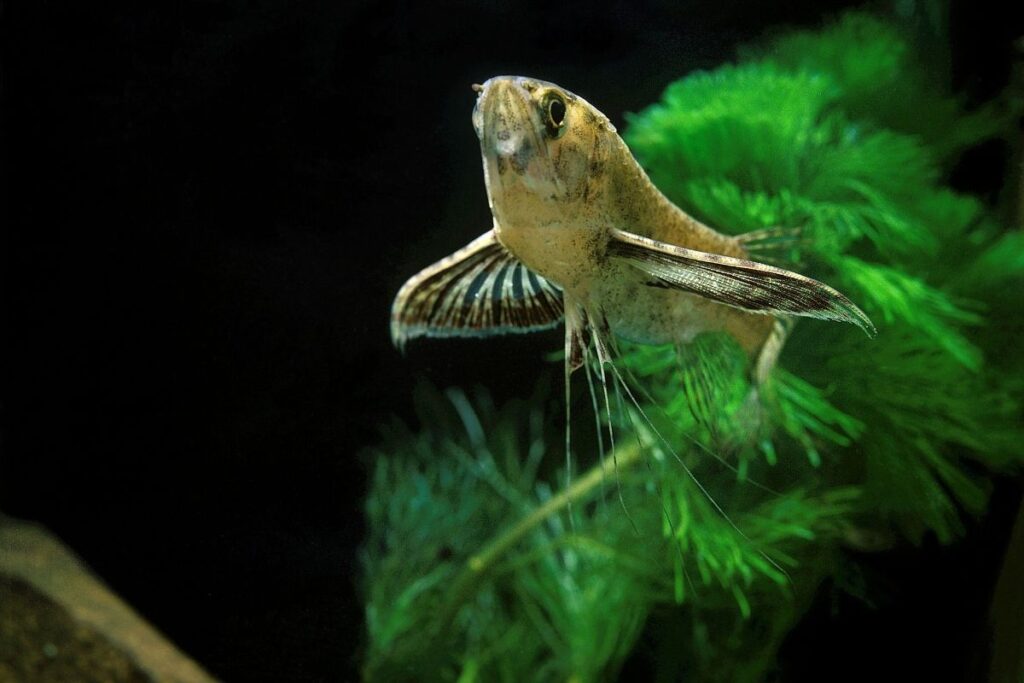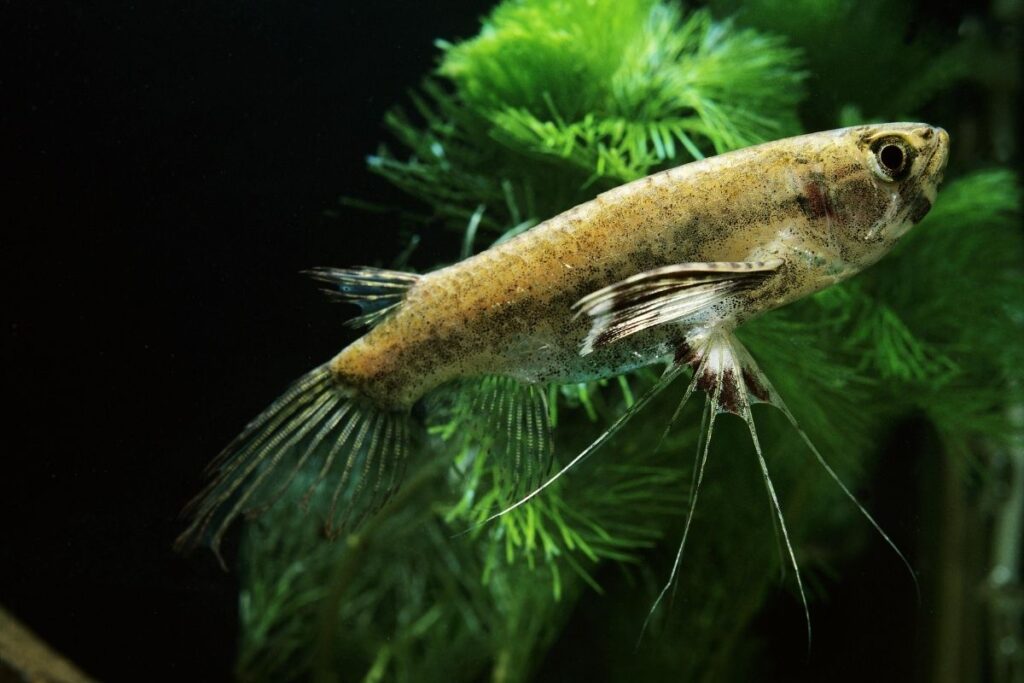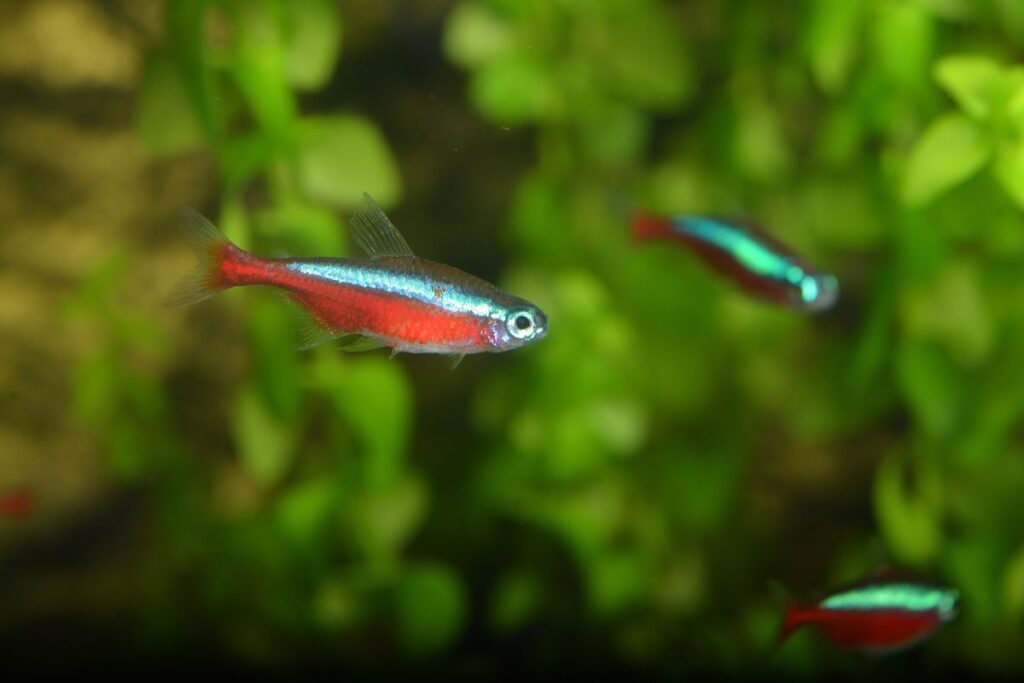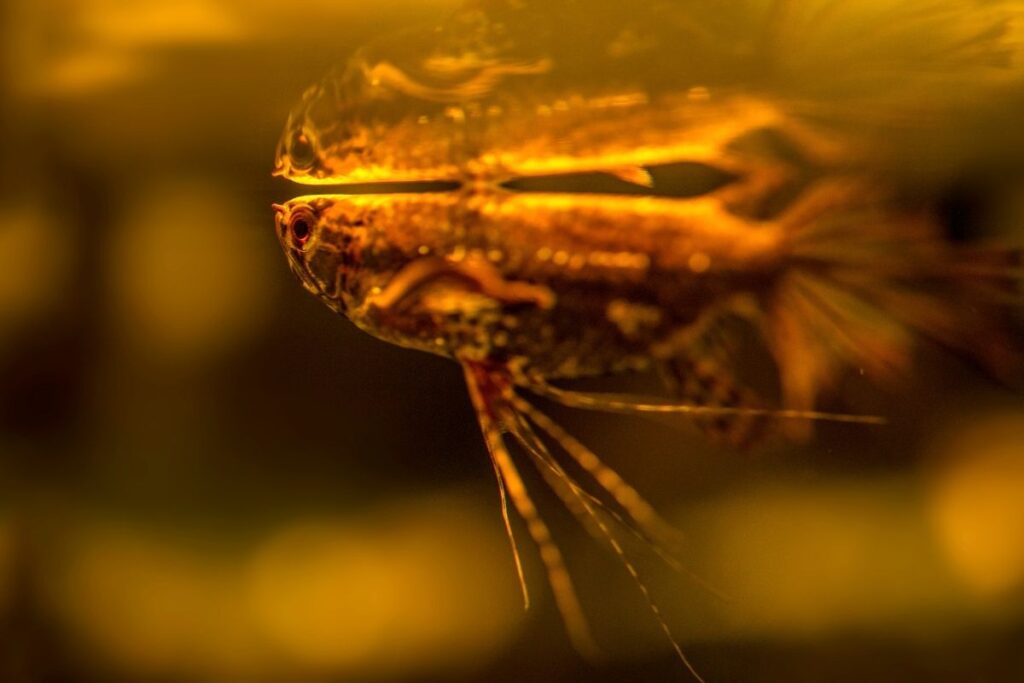If you’re looking for a unique and fascinating addition to your aquarium, an African Butterfly Fish(also known as freshwater butterflyfish) may be just what you need. As an aquarium owner and fish enthusiast, I’ve always been drawn to this species for its beauty and unusual behavior. However, caring for these fish requires a bit of extra attention and knowledge.
African Butterflies require a heavily planted aquarium with soft, slightly acidic water. They are peaceful and should be kept in groups of at least six. They feed on small live foods such as brine shrimp and daphnia, and their diet can be supplemented with high-quality flakes and pellets. Regular water changes and maintenance are essential for their health.
One of the most important things to know about African Butterfly Fish care is that they require a specific environment to thrive. They are native to slow-moving, heavily vegetated waters in Africa, and need a similar setup in captivity. This means providing plenty of plants, driftwood, and hiding spots, as well as keeping the water temperature and pH levels within a specific range.
In addition to their unique environment needs, African Butterfly Fish also have specific dietary requirements. They are carnivorous and typically feed on insects and small fish in the wild. In captivity, they can be fed a variety of live or frozen foods, such as bloodworms, brine shrimp, and small pieces of fish. It’s important to avoid overfeeding, as these fish are prone to obesity and other health issues.

Table of Contents
Species Summary
Looking to add a unique fish to your aquarium? The African Butterfly Fish might be just what you’re looking for! Here’s everything you need to know about caring for this fascinating species.
Origin
The African Butterfly Fish, or Pantodon buchholzi, is native to the freshwaters of West and Central Africa. They can be found in slow-moving rivers, streams, and swamps.
Lifespan
With proper care, African Butterfly Fish can live up to 5 years in captivity. However, it’s important to note that their lifespan can be affected by factors such as water quality, diet, and tank size.
Appearance
African Butterfly Fish are known for their unique appearance. They have a flat, elongated body with large, fan-like pectoral fins that resemble butterfly wings.
Their coloration can vary, but they typically have a brownish-gray base with darker markings.
Size
These fish can grow up to 4-5 inches in length, making them a medium-sized species.
It’s important to keep this in mind when selecting a tank size for your fish.
Growth Rate
African Butterfly Fish grow relatively slowly, so it’s important to provide them with a healthy diet and suitable living conditions to ensure they reach their full potential.
Behavior & Temperament
African Butterfly Fish are known for their unique hunting behavior. They are surface-dwelling fish that feed on insects and other small creatures that land on the water’s surface.
They are also known to be quite territorial, so it’s important to provide them with plenty of hiding places and space to swim.
Male vs Female
It can be difficult to tell the difference between male and female African Butterfly Fish.
However, females are typically larger and rounder than males.
When I first added an African Butterfly Fish to my aquarium, I was amazed by its unique appearance and hunting behavior.
Watching it glide gracefully through the water and snatch insects from the surface was truly a sight to behold. With proper care, these fish can make a fascinating addition to any aquarium.
Tank Setup
Tank Size
I recommend a minimum tank size of 20 gallons for African Butterfly Fish.
These fish are known to jump out of tanks, so make sure to have a tight-fitting lid.
Lighting
These fish prefer dimly lit environments, so avoid bright lights. You can use floating plants to provide shade and cover for your fish.
Filtration & Aeration
A good filtration system is essential to maintain water quality.
You can use a hang-on-back filter or a canister filter. Aeration is also important to maintain oxygen levels in the water.
Heater
African Butterfly Fish are tropical fish and require a water temperature between 75-82°F.
Use a reliable heater to maintain the temperature.
Substrate
You can use sand or fine gravel as substrate.
Avoid using large gravel or sharp-edged substrate that can injure your fish.
Decoration
You can add driftwood, rocks, and caves to provide hiding places for your fish.
Make sure the decorations are not sharp or have rough edges that can injure your fish.
Plants
You can use live or artificial plants to provide cover and hiding places for your fish.
African Butterfly Fish prefer floating plants like Amazon Frogbit, Water Lettuce, and Duckweed.
When I first got my African Butterfly Fish, I made the mistake of using a bright light and large gravel substrate. My fish were stressed and didn’t eat for days.

After making the necessary changes to my tank setup, my fish became more active and started eating again.
Water Quality
As an African Butterfly Fish owner, it’s essential to maintain the water quality of their tank. Poor water quality can lead to various health problems and even death.
Here are some aspects of water quality to keep in mind:
Water Temperature
The ideal temperature range for African Butterfly Fish is between 75-82°F (24-28°C).
It’s crucial to maintain a stable temperature in the tank, as sudden changes can cause stress and illness. I use a reliable heater to keep the water temperature consistent.
Water pH
The optimal pH range for African Butterfly Fish is between 6.5-7.5. It’s essential to monitor the pH level regularly, as fluctuations can cause stress and harm to the fish.
I use a pH testing kit to ensure the pH level remains stable.
Water Hardness
African Butterfly Fish prefer soft to moderately hard water, with a range of 5-12 dGH. Hard water can cause stress and health problems for the fish.
I use a water hardness testing kit to maintain the ideal water hardness level.
Water Changes
Regular water changes are crucial for maintaining the water quality of the tank. I change 20-30% of the water in the tank every week.
It’s essential to use a dechlorinator to remove any harmful chemicals from tap water before adding it to the tank. I also vacuum the substrate during water changes to remove any debris or waste.
By keeping an eye on these aspects of water quality, you can ensure that your African Butterfly Fish remains healthy and happy in their tank.
Personally, I’ve found that maintaining the water quality of my African Butterfly Fish’s tank has been a rewarding experience. Seeing my fish thrive in their environment brings me joy and satisfaction, and I’m always learning new ways to improve their care.
Tank Maintenance
Keeping a clean and healthy environment is crucial for the well-being of your African Butterfly Fish.
As an owner, I have found that regular tank maintenance is key to ensuring that my fish remain healthy and happy.
One of the most important things to keep in mind when it comes to tank maintenance is water quality. African Butterfly Fish require clean water that is well-oxygenated.
I recommend doing partial water changes every week to maintain good water quality. I usually change about 20-25% of the water in my tank each week.
In addition to water changes, it’s important to keep the tank clean. I use a gravel vacuum to clean the substrate and remove any debris that has accumulated.
I also clean the tank walls and decorations with an algae scraper to prevent the buildup of algae and other unsightly substances.
Another aspect of tank maintenance is monitoring the water temperature. African Butterfly Fish prefer water temperatures between 75-82°F.
I use a reliable aquarium heater to maintain a consistent temperature in my tank. It’s important to check the temperature regularly to ensure that it remains within the appropriate range.
Finally, it’s important to keep an eye on the overall health of your fish. I regularly check my African Butterfly Fish for signs of illness or injury.
If I notice anything out of the ordinary, I take action immediately to address the issue and prevent it from getting worse.
Overall, tank maintenance is an essential part of caring for African Butterfly Fish.
By keeping the water clean and well-oxygenated, monitoring the temperature, and ensuring the overall health of your fish, you can create a happy and healthy environment that will allow them to thrive.
Personally, I have found that taking the time to maintain my tank has been a rewarding experience. Not only do my fish look and feel better, but I also feel a sense of pride in knowing that I am providing them with the best possible care.
Tank Mates
Compatible Fish Species
I have found that African Butterfly Fish are generally peaceful fish, and they can be kept with other non-aggressive fish species. Some good tank mates for African Butterfly Fish include:

- Gouramis
- Tetras
- Corydoras Catfish
- Otocinclus Catfish
- Small Plecos
Incompatible Fish Species
However, there are some fish species that are not compatible with African Butterfly Fish.
These fish can be too aggressive or too small to be kept with African Butterfly Fish. Some fish species that should not be kept with African Butterfly Fish include:
- Cichlids
- Barbs
- Danios
- Guppies
- Sharks
How Many African Butterfly Fish Together
When it comes to keeping African Butterfly Fish together, it is best to keep them in groups of three or more. This will help to reduce aggression and stress among the fish.
However, it is important to make sure that the tank is large enough to accommodate multiple African Butterfly Fish.
I have personally kept African Butterfly Fish with Gouramis and Tetras in a 55-gallon tank, and they have all coexisted peacefully.
However, I have also seen instances where African Butterfly Fish have been aggressive towards other fish species, so it is important to monitor their behavior closely.
Diet
As a proud owner of an African Butterfly Fish, I know that feeding them can be a bit tricky. But don’t worry, with a little bit of knowledge and patience, it’s easy to keep your fish happy and healthy.
Here’s everything you need to know about feeding your African Butterfly Fish.
What To Feed
African Butterfly Fish are carnivorous and prefer live food. They love to hunt and will eat almost anything that moves, including small fish, insects, and crustaceans.
You can feed them live or frozen food such as bloodworms, brine shrimp, and small fish like guppies or minnows. You can also give them pellets or flakes, but they may not eat them as readily as live food.
Frequency
I recommend feeding your African Butterfly Fish once a day. Overfeeding can cause health problems, so it’s important to be mindful of how much you’re feeding them.
You can feed them as much as they can eat in two minutes, and remove any uneaten food from the tank after feeding.
Tips
- Provide a variety of food to keep your fish interested and healthy.
- Feed your fish at the same time every day to establish a routine.
- Make sure the food is appropriate for the size of your fish. Small fish need small food, and large fish need larger food.
- Consider using a feeding cone or target feeding to make sure your African Butterfly Fish gets enough food and to prevent overfeeding.
- Keep an eye on your fish to make sure they are eating and behaving normally. If you notice any changes in their behavior, it could be a sign of illness or stress.
Feeding your African Butterfly Fish can be a rewarding experience. With the right food and care, your fish will thrive and bring you joy for years to come.
Common Diseases
Diseases
I have been keeping African Butterfly Fish for a while now, and I have learned that they are susceptible to various diseases. Some of the common diseases that affect these fish include:
- Fin rot
- Ich
- Columnaris
Symptoms
It is essential to keep an eye on your African Butterfly Fish and look out for any symptoms of diseases. Some of the common symptoms to watch out for include:
- White spots on the body
- Discolored or frayed fins
- Open sores or ulcers
Treatment
If you notice any of the symptoms mentioned above, it is crucial to act fast and treat your fish. The treatment will depend on the type of disease affecting your fish. Some of the common treatments include:
| Disease | Treatment |
|---|---|
| Fin Rot | Antibiotics and clean water |
| Ich | Increased temperature, salt baths, and medication |
| Columnaris | Antibiotics and clean water |
Prevention
Prevention is always better than cure when it comes to fish diseases. Here are some tips to prevent diseases in your African Butterfly Fish:
- Quarantine new fish before introducing them to the tank
- Keep the water clean and well-maintained
- Avoid overcrowding the tank
- Feed your fish a balanced diet
Overall, it is essential to keep a close eye on your African Butterfly Fish and take action if you notice any symptoms of diseases. With proper care and attention, you can keep your fish healthy and happy.
One time, I noticed that one of my African Butterfly Fish had white spots on its body. I immediately knew that it was ich and started treating it with increased temperature and medication.
Thankfully, the fish recovered, and I learned the importance of keeping a close eye on my fish and acting fast when I notice any symptoms of diseases.
Signs of a Healthy African Butterfly Fish

When it comes to African Butterfly Fish care, it’s important to know the signs of a healthy fish. As an aquarium enthusiast, I have learned that a healthy fish is a happy fish, and a happy fish is a joy to watch.
Here are some signs that your African Butterfly Fish is healthy:
- Active and Alert: A healthy African Butterfly Fish is active and alert. It will swim around the tank, explore its surroundings, and react to stimuli. If your fish is lethargic or not swimming around, it could be a sign of illness.
- Good Appetite: A healthy African Butterfly Fish has a good appetite. It will eagerly eat when you feed it and won’t refuse food. If your fish is not interested in food or is refusing to eat, it could be a sign of illness.
- Clear Eyes and Skin: A healthy African Butterfly Fish has clear eyes and skin. Its eyes should be bright and clear, and its skin should be free of any lesions or discolorations. If you notice any abnormalities, it could be a sign of illness.
- Healthy Fins: A healthy African Butterfly Fish has healthy fins. Its fins should be intact, free of any tears or holes, and not clamped. If you notice any damage to the fins, it could be a sign of illness or poor water conditions.
- Good Water Quality: A healthy African Butterfly Fish requires good water quality. Make sure the water is clean, clear, and free of any toxins or pollutants. Test the water regularly to ensure that the pH, ammonia, nitrite, and nitrate levels are within the appropriate range.
In conclusion, taking care of an African Butterfly Fish requires attention to detail and careful observation.
By keeping an eye out for these signs of a healthy fish, you can ensure that your pet is happy, healthy, and thriving in its aquarium home.
Signs Your African Butterfly Is Sick
As a fish owner, it’s essential to keep an eye on your African Butterfly Fish to ensure they are healthy and happy. Here are some signs that your African Butterfly Fish may be sick:
Firstly, if your fish is not eating, it could be a sign of illness. Loss of appetite can be a symptom of many illnesses, including bacterial infections, parasites, and more.
Secondly, if your fish is swimming erratically or appears to be uncoordinated, it could be a sign of swim bladder disease. This disease can be caused by overfeeding, a poor diet, or bacterial infections.
Thirdly, if your fish is constantly scratching against decor or the aquarium walls, it could be a sign of parasites. Parasites can be treated with medication, so it’s essential to act quickly if you notice this behavior.
Lastly, if your fish is exhibiting any physical symptoms, such as discoloration, sores, or bloating, it could be a sign of illness. These symptoms could be indicative of a bacterial infection, a fungal infection, or more.
It’s important to note that these symptoms can be indicative of many different illnesses, so it’s essential to consult with a veterinarian or a fish expert to determine the cause of the symptoms and the appropriate course of action.
Personally, I once noticed that my African Butterfly Fish was not eating and was swimming erratically. After consulting with a fish expert, I learned that my fish had swim bladder disease and needed to adjust its diet. With the right care and attention, my fish made a full recovery.
Breeding
Breeding Setup
When it comes to breeding African Butterfly Fish, a setup that mimics their natural habitat is crucial. I recommend a tank with a minimum size of 20 gallons, densely planted with floating plants and tall stems.
The water temperature should be around 75-80°F, with a pH level between 6.5-7.5. A dimly lit tank with plenty of hiding spots is also essential, as these fish are shy and easily stressed.
How To Breed
Before breeding, it’s important to make sure your fish are healthy and well-fed. Once you’ve identified a male and female, introduce them to the breeding tank and wait for them to pair up.
The male will begin to chase the female around the tank, and eventually, the female will lay her eggs on the surface of the water. The male will then fertilize the eggs.
It’s important to note that African Butterfly Fish are not easy to breed, and it may take several attempts before you are successful.
Patience is key, and it’s important to monitor the water quality and temperature closely during the breeding process.
Care
Once the eggs have been fertilized, it’s important to remove the adult fish from the breeding tank to prevent them from eating the eggs.
The eggs will hatch in 3-4 days, and the fry will begin to swim freely after a week. At this point, you can begin to feed them small live foods such as brine shrimp or daphnia.
It’s important to keep the water quality high during this time, as the fry are vulnerable to disease and pollution. Regular water changes and careful monitoring of the water parameters are essential.
Personally, I found breeding African Butterfly Fish to be a challenging but rewarding experience. It took several attempts before I was successful, but seeing the fry swim freely for the first time made it all worth it.
Product recommendations for Freshwater Butterflyfish:
- Hikari Micro Pellets – This is a high-quality fish food that is perfect for Freshwater Butterflyfish. It contains all the essential nutrients that your fish need to stay healthy and vibrant.
- API Aquarium Water Test Kit – It is important to keep an eye on the water quality in your aquarium, and this test kit makes it easy to do so. It includes tests for ammonia, nitrite, nitrate, and pH.
- Seachem Prime – This is a water conditioner that helps to detoxify ammonia, nitrite, and nitrate in your aquarium. It is safe for use with Freshwater Butterflyfish and other fish.
- Fluval Plant and Shrimp Stratum – If you plan on keeping live plants in your aquarium, this substrate is a great choice. It provides the nutrients that plants need to thrive, and also helps to maintain a stable pH.
- AquaClear Power Filter – This filter is highly effective at removing debris and maintaining water quality in your aquarium. It is also very quiet and easy to maintain.
- Aqueon Aquarium Water Changer – This device makes it easy to perform regular water changes in your aquarium. It is designed to be safe and easy to use, and can help to keep your Freshwater Butterflyfish healthy.
- Zoo Med Nano 10 External Canister Filter – This is a small and efficient filter that is perfect for smaller aquariums housing Freshwater Butterflyfish. It is easy to install and maintain, and will keep the water in your aquarium clean and healthy.
- Marina LED Aquarium Kit– This is another great aquarium kit that is perfect for Freshwater Butterflyfish. It includes a filter, heater, and LED lighting, and is easy to set up and maintain.
Conclusion
Overall, caring for African Butterfly Fish requires some effort, but it is definitely worth it. These unique fish are fascinating to watch, and they can make a great addition to any aquarium.
If you’re considering getting an African Butterfly Fish, be sure to do your research and prepare accordingly. Make sure you have a tank that is large enough and properly set up, and be sure to provide your fish with a varied diet.
I personally love my African Butterfly Fish and enjoy watching it glide through the water. With a little bit of effort, you too can enjoy the beauty of these amazing fish in your own home.
FAQs
As someone who has cared for African Butterfly Fish for several years, I’ve received many questions about their care. Here are some of the most frequently asked questions:
Q: What should I feed my African Butterfly Fish?
A: African Butterfly Fish are carnivorous and primarily eat insects and small fish in the wild. In captivity, they can be fed a variety of live and frozen foods, such as bloodworms, brine shrimp, and small pieces of fish. I recommend offering a variety of foods to ensure they receive a balanced diet.
Q: How often should I feed my African Butterfly Fish?
A: It is best to feed African Butterfly Fish small meals multiple times a day rather than one large meal. I feed my fish twice a day, but you can adjust the frequency based on the fish’s appetite and behavior.
Q: How big of a tank do I need for African Butterfly Fish?
A: African Butterfly Fish can grow up to 6 inches in length and require a minimum tank size of 20 gallons. However, I recommend a larger tank if you plan on keeping multiple fish or other tank mates.
Q: Can African Butterfly Fish live with other fish?
A: African Butterfly Fish are predatory and will eat smaller fish, so it is best to keep them with larger fish or other African Butterfly Fish. I have successfully kept my fish with larger tetras and gouramis, but it is important to monitor their behavior and feeding habits.
Q: Do African Butterfly Fish need a heater?
A: African Butterfly Fish are tropical fish and require a water temperature between 75-82°F. A heater is necessary to maintain a consistent temperature in the tank.
Q: How often should I clean my African Butterfly Fish’s tank?
A: It is important to perform regular water changes to maintain good water quality. I recommend changing 25% of the water once a week and cleaning the filter every 4-6 weeks.
These are just a few of the most common questions I receive about African Butterfly Fish care. If you have any more questions, feel free to reach out to me.
Reference: Wikipedia.
